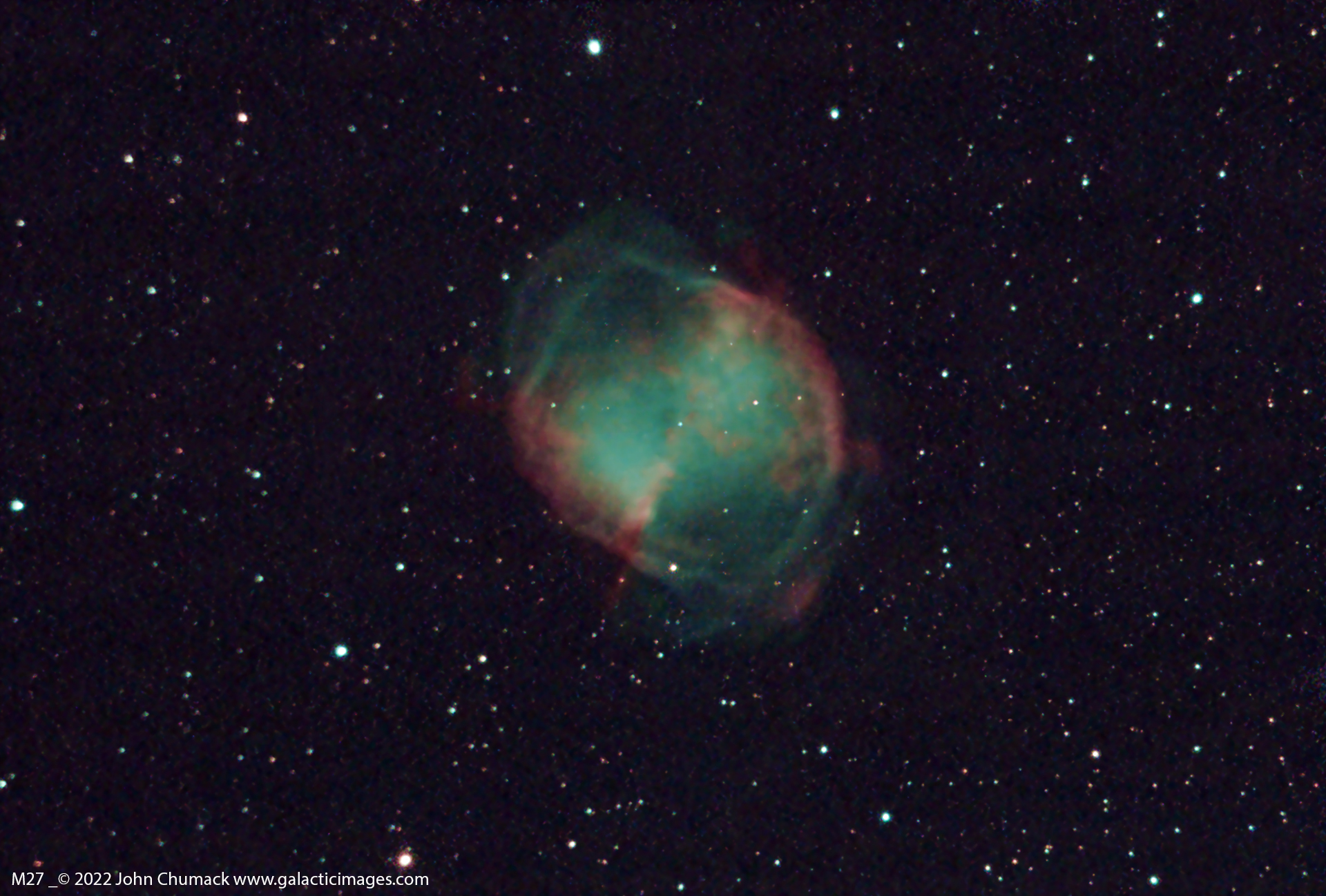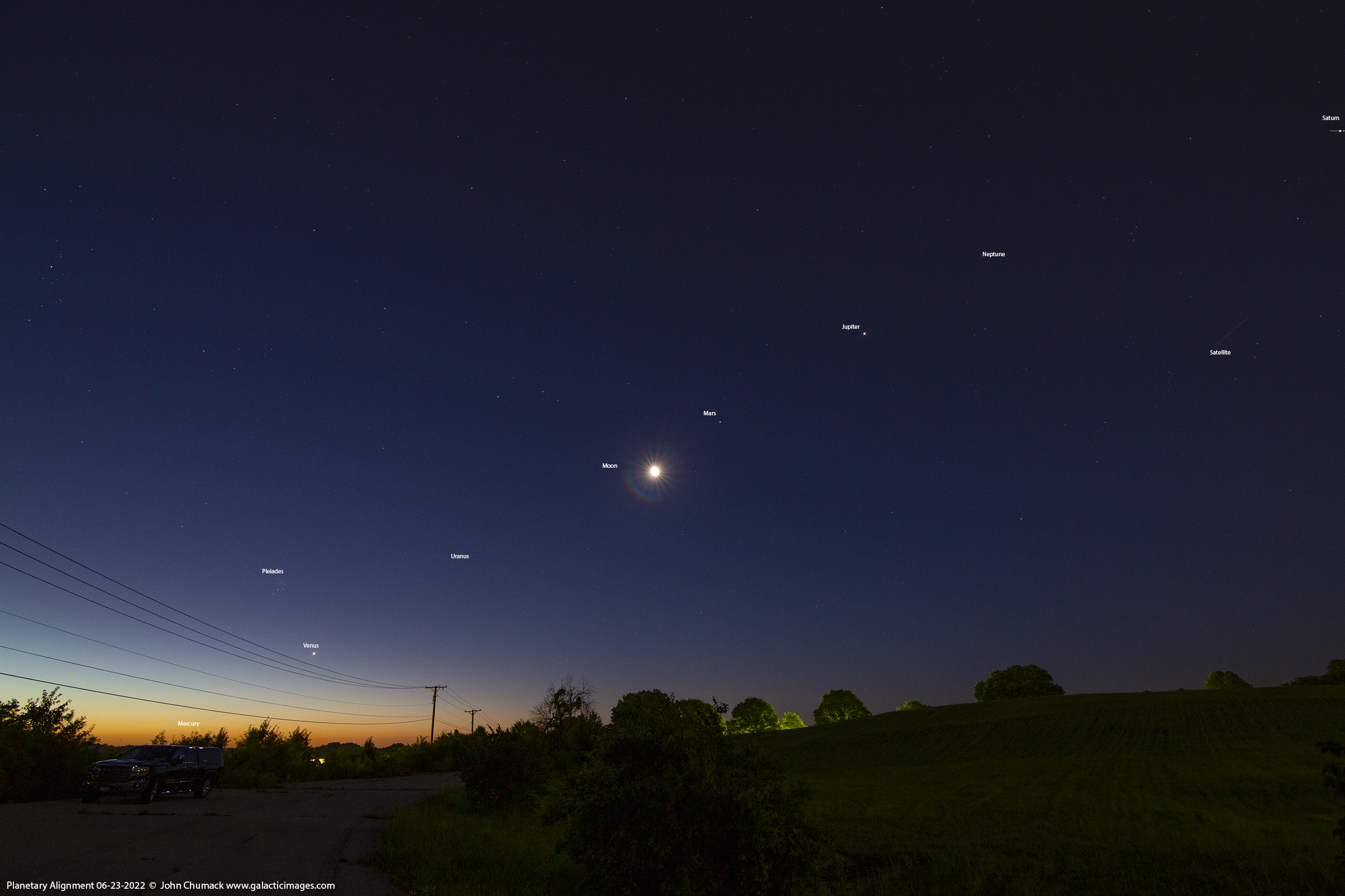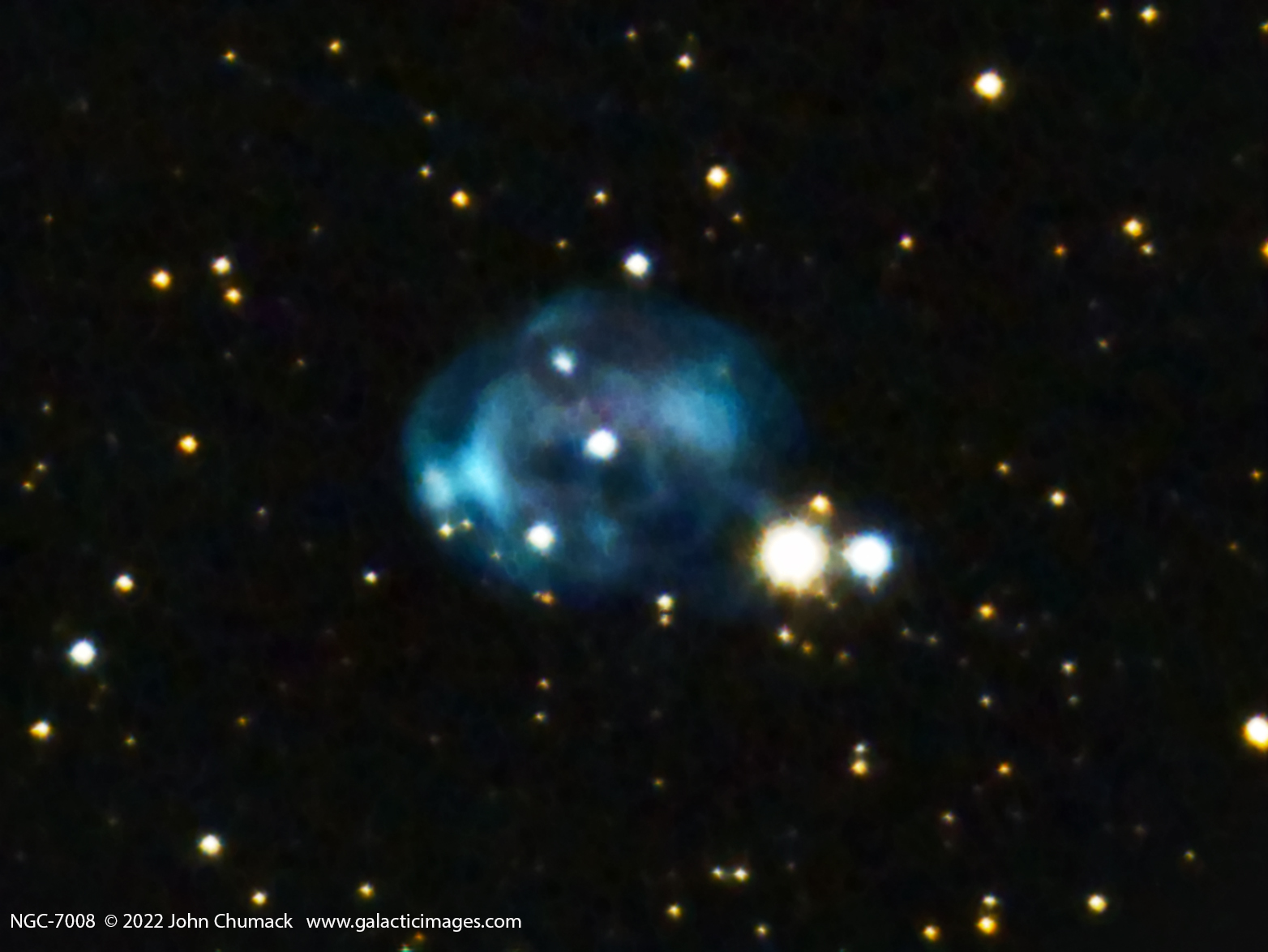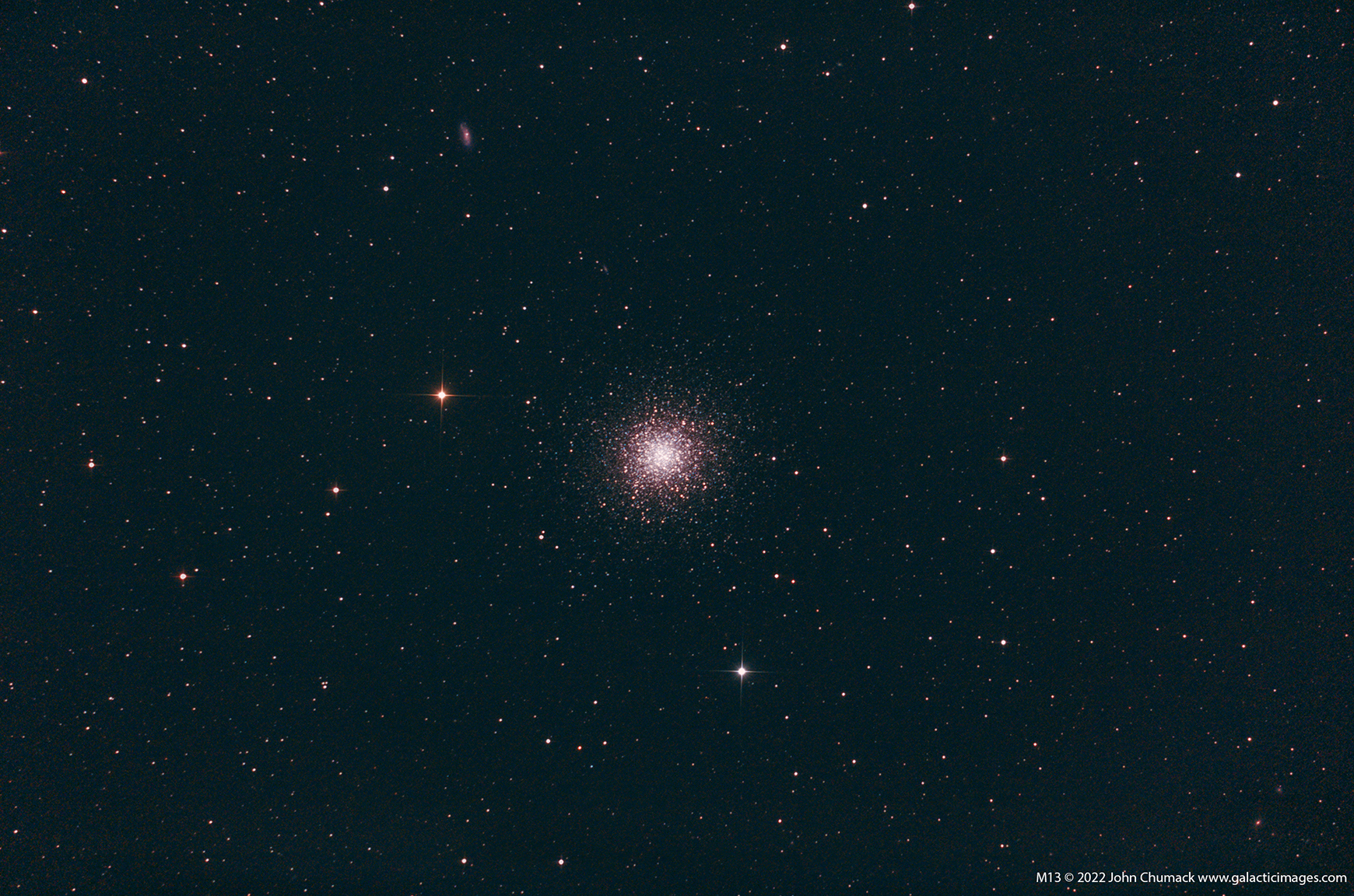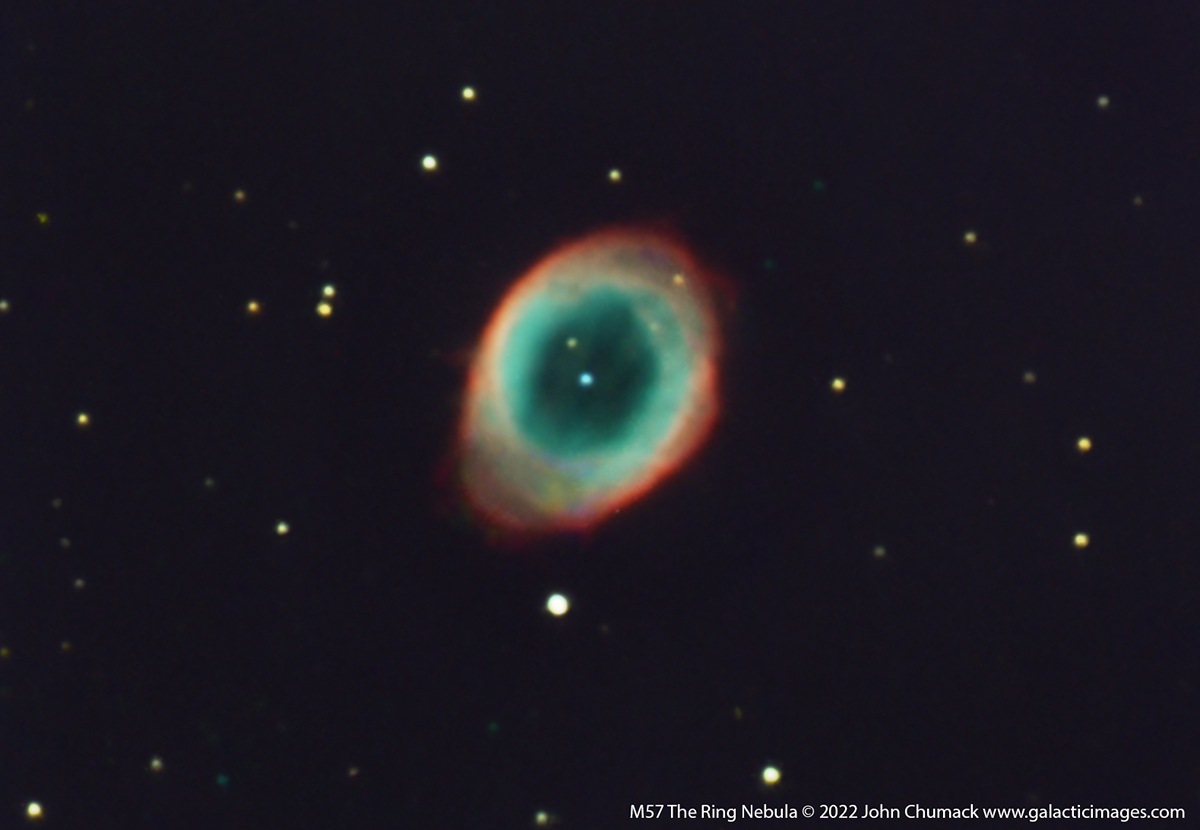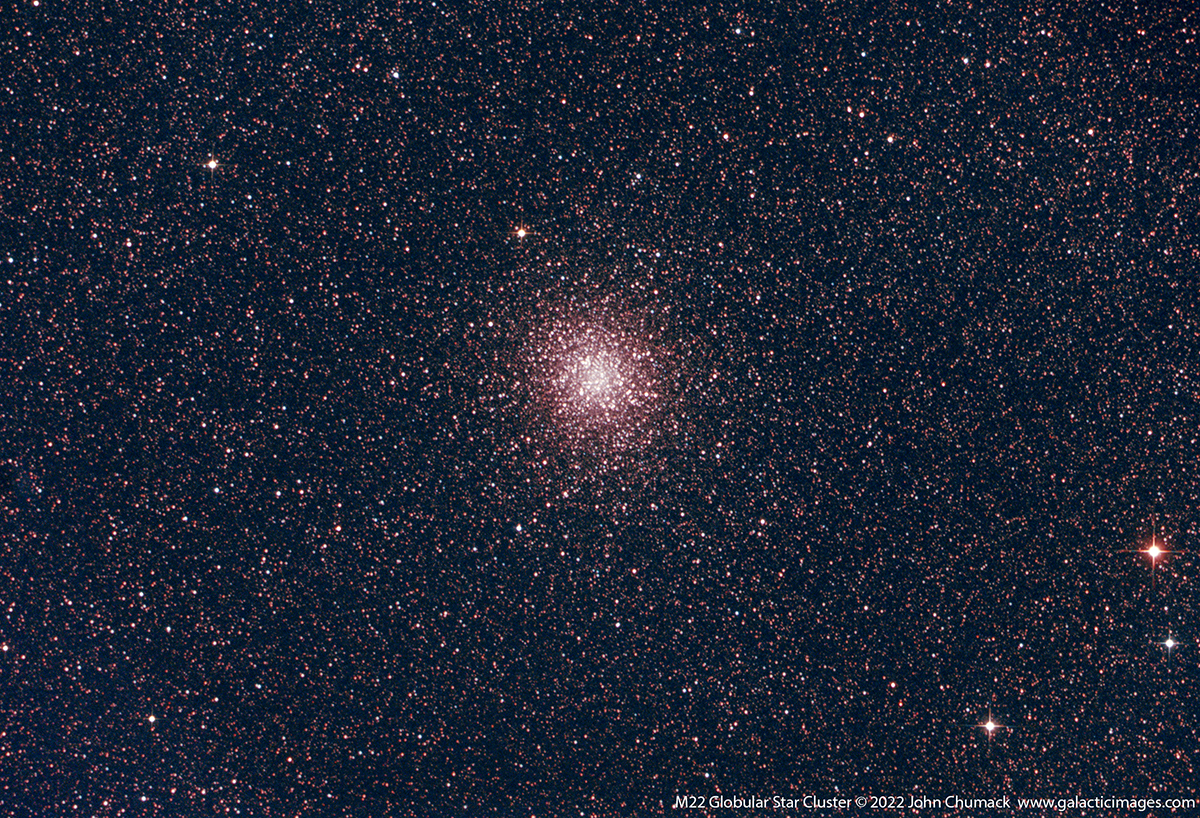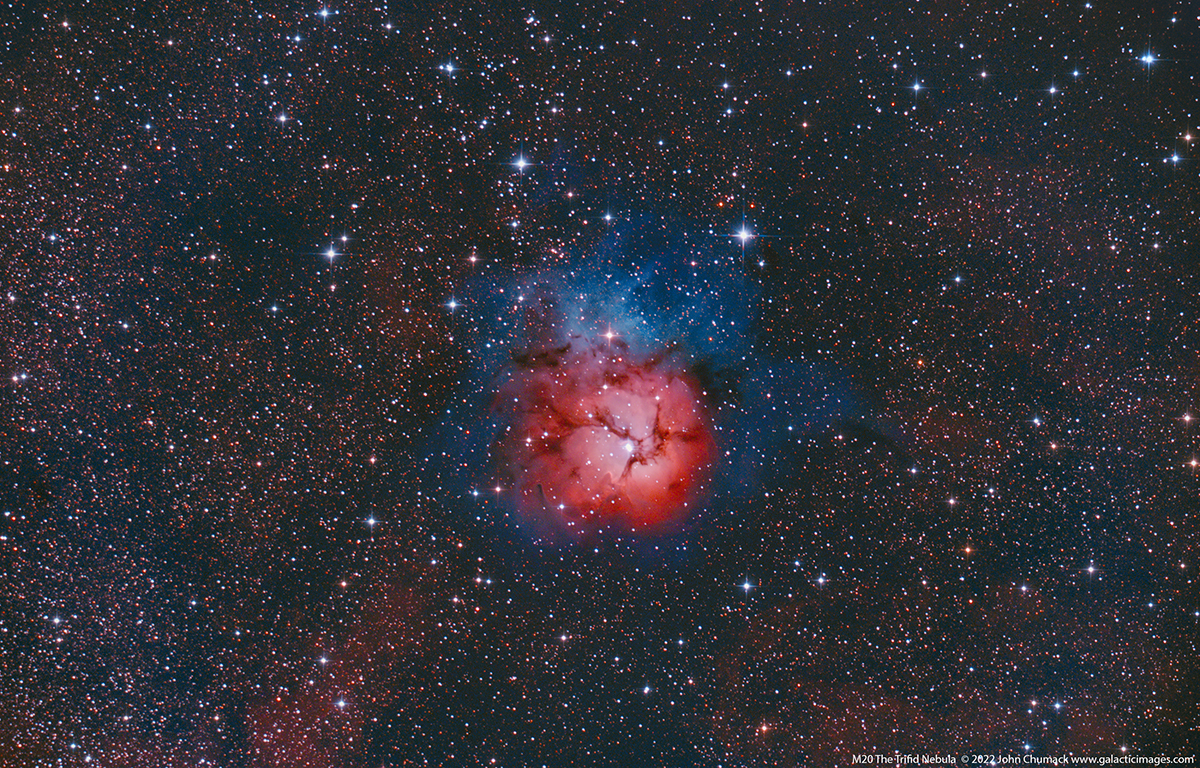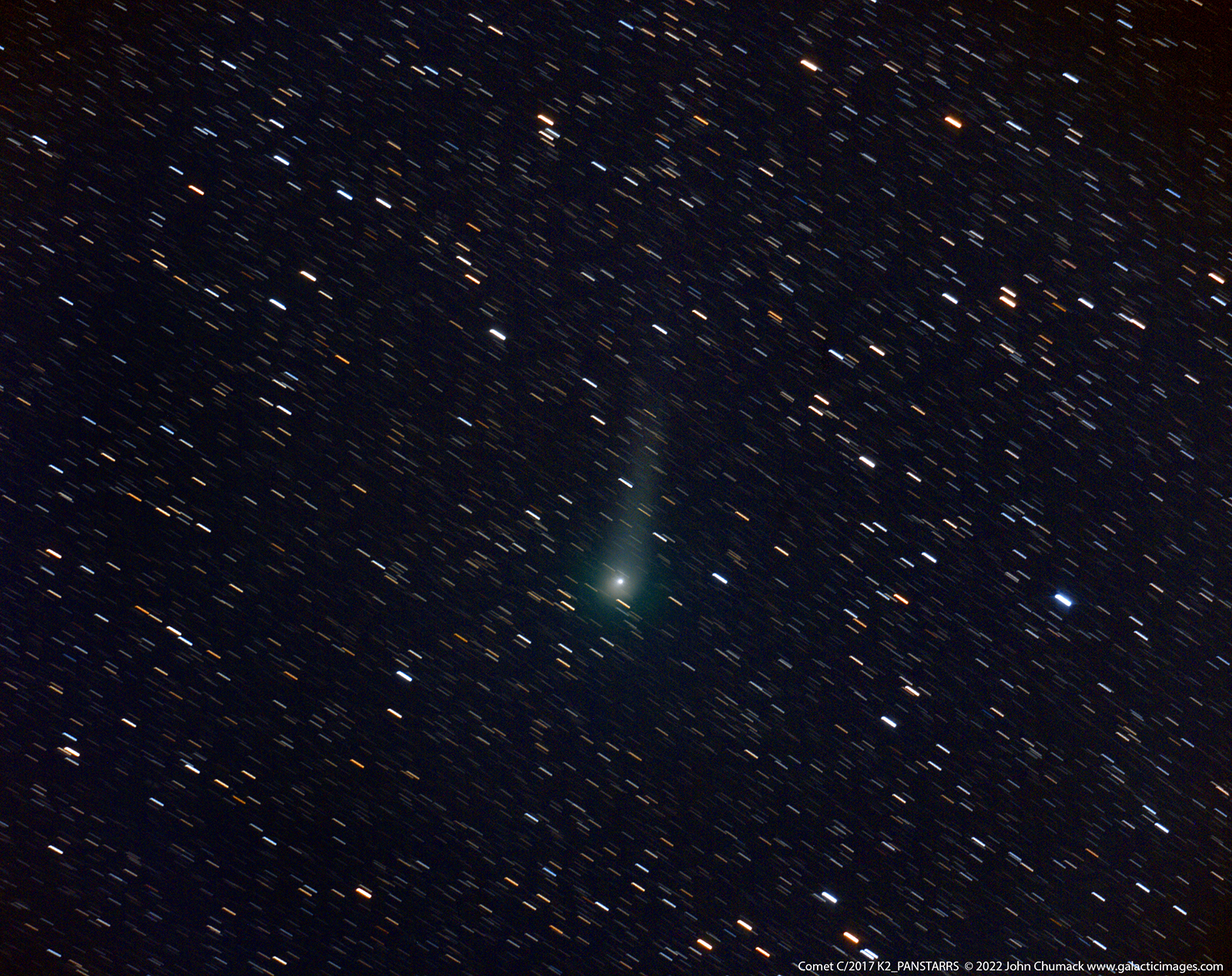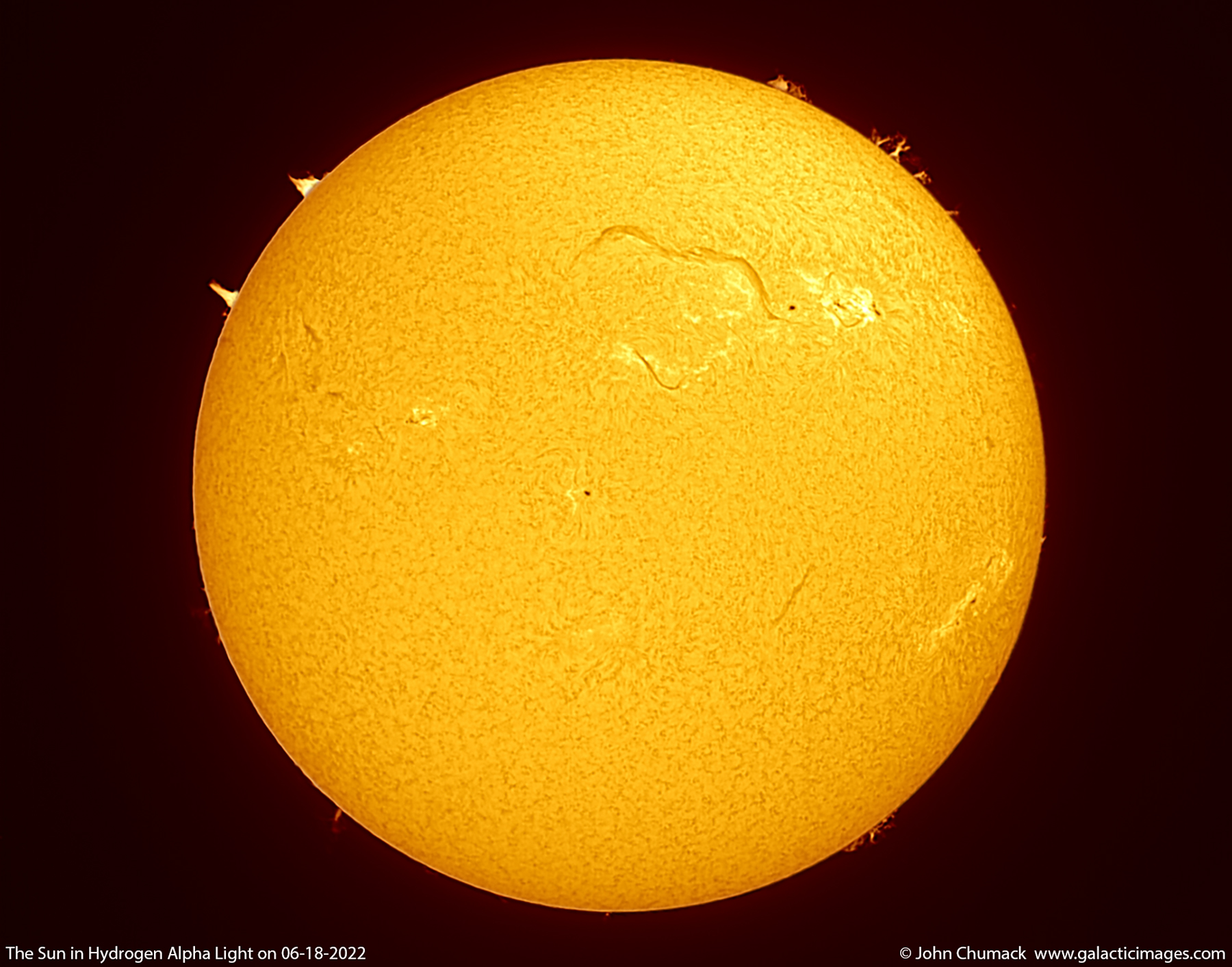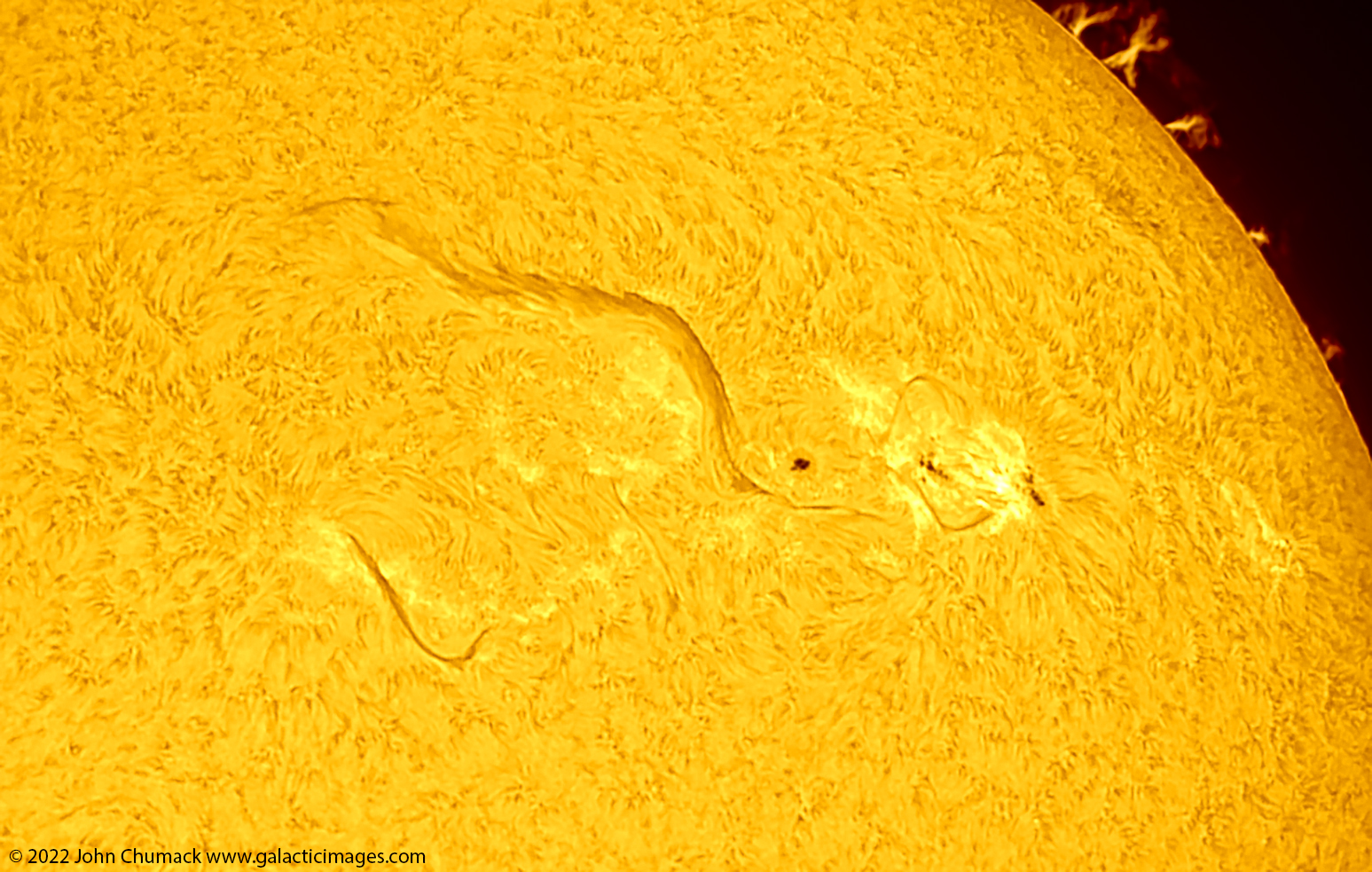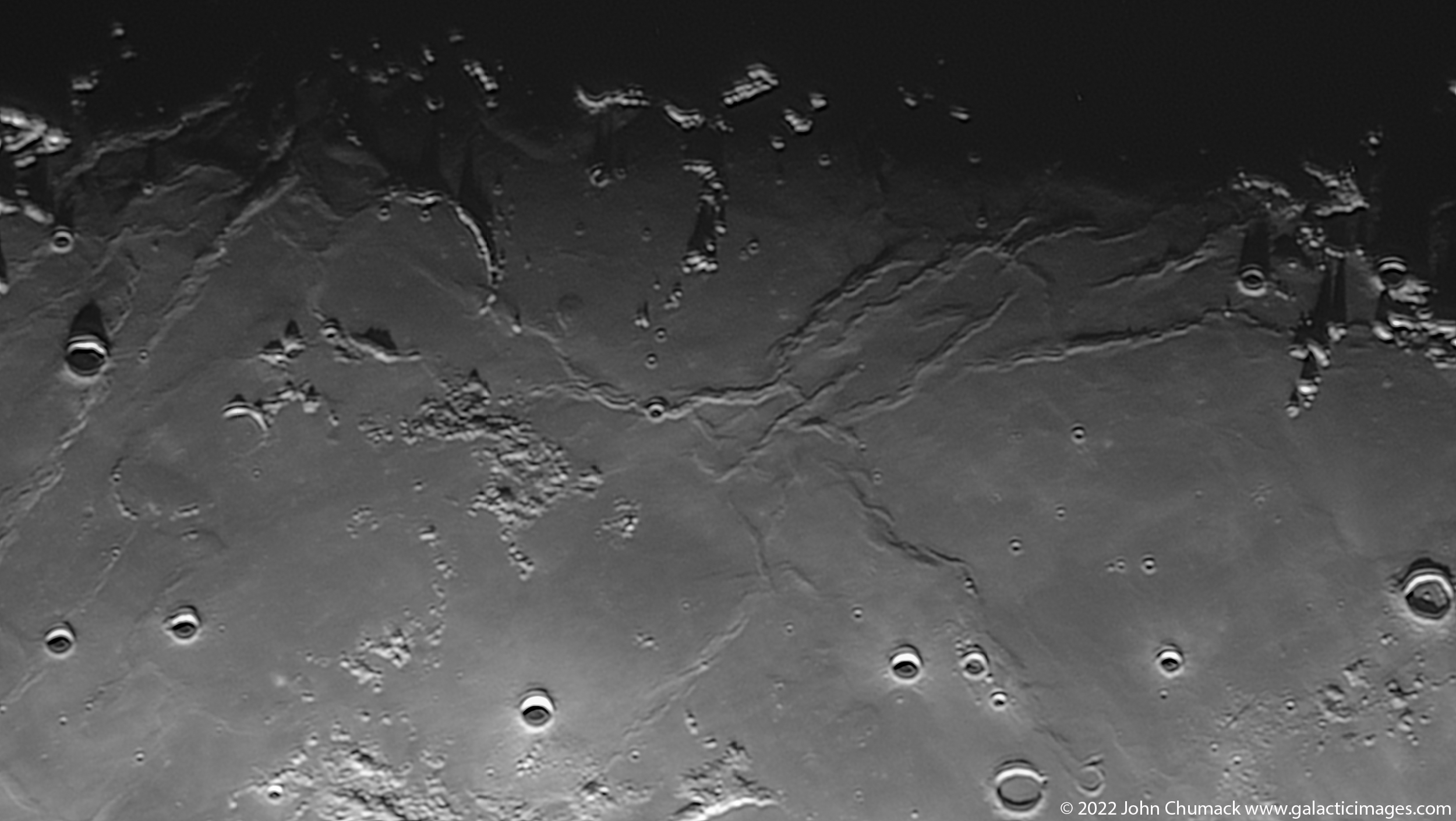M27 The Dumbbell or Apple Core Planetary Nebula – A Close-up of a dying star
The Great Planetary Alignment 2022
NGC-7008 The Fetus Planetary Nebula, An Extreme Close-up!
Here is my Extreme Close-up of the Fetus Nebula.
NGC-7008 Planetary Nebula in Cygnus, A dying star that is blowing off its outer atmosphere, also called the Fetus Nebula.
It shines at 12th magnitude and is located 2,800 light years away from Earth.
C-11 Telescope F10, Bisque MYT Mount, ZWO 224MC Uncooled(very small chip) Cmos Camera, ASI AIR WIFI Capture,
I used a “Lucky Imaging” method, visible light only, 90 x 20sec subs, 30 minute total exposure integration time. No Crop, original FOV.
Captured on 06-18-2022 from my backyard observatory(Bortle 8) in Dayton, Ohio. Seeing wasn’t the best but went for it anyway.
Best Regards,
John Chumack
M13 Globular Star Cluster with Galaxies NGC 6207 and IC 4617
M57 The Ring Nebula (Close-up of a dying star) 07-03-2022
M57 The Ring Nebula (Close-up of a dying star)
The Ring Nebula is one of the most famous Planetary Nebulae and is a classic example of a dying star.
The central star has blown off its outer atmosphere and the UV light energizes the gases to make this one of the brightest planetary nebulae in the sky.
Such a nebula is formed when a star, during the last stages of its evolution before becoming a white dwarf, expels a vast luminous envelope of ionized gas into the surrounding interstellar space.
Located in the constellation of Lyra, it is very easy to see with even the smallest of telescopes.
M57 shines at magnitude 8.8 and visually it is a delight, and we see it quite well in most telescopes with a little magnification as a smoke ring or Cheerio in the sky. its diameter is 2.6 light years and is located 2,283 light years from Earth.
Note the blue central star, it shines at magnitude 15, and several other faint background stars are visible.
Celestron C-11 SCT Telescope at F10, Bisque MyT Mount, ZWO ASI Air, ZWO 224MC uncooled Color Camera(OSC), no NB filters, just Visible light.
I captured 142 x 20 sec subs exposures for a total of 47.3 minutes total integration time. No auto-guiding, just dithering to help remove noise as my ambient temp was 32C.
Calibrated and Stacked in Nebulosity, Adobe RAW CS 2022.
Captured from my backyard Observatory in Dayton, Ohio on 07-03-2022.
I was surprised it came out OK with all the Smoke from the fireworks going off in my bortle 8 neighborhood this holiday weekend.
Best Regards,
John Chumack
www.galacticimages.com
M22 Globular Star Cluster on 06-18-2022
Here is one of my latest shots captured with my TPO 12” F4 Newtonian Telescope, Bisque ME Mount, and HAP Modified Canon 6D DSLR Camera, ISO 800, 20 minute exposure on 06-18-2022 at my Observatories in JBSPO in Yellow Springs, Ohio.
Messier 22 or M22, also known as NGC 6656, is an elliptical globular cluster of stars in the constellation Sagittarius,
near the Galactic bulge region. It is one of the brightest globulars visible in the night sky.
M22 can be seen with the naked eye from a dark location. The best time to observe the cluster is during July & August.
M22 is easily visible in Binoculars or a small telescope.
M22 has a diameter of about 100 light years, It is said to contain over 500,000 stars.
Located 10,000 light-years from Earth, the cluster’s relatively bright apparent magnitude of 5.1 makes it a popular target for today’s amateur astronomers.
You can find it just above the top of the Teapot Asterism in Sagittarius.
Containing some of the oldest known stars, globular clusters are popular objects of study for astronomers.
This bright globular cluster sits amongst one of the richest of star fields near the central bulge of our Milky Way Galaxy.
Best Regards,
John Chumack
www.galacticimages.com
M20 The Trifid Nebula in Sagittarius
M20 The Trifid Nebula in Sagittarius
The Trifid Nebula (catalogued as Messier 20 or M20 and as NGC 6514) is an H II region in the north-west of Sagittarius in a star-forming region.
The Trifid is divided into three lobes of red Emission nebula, also it has a blue reflection nebula at the top, and the dark nebula are what divides the 3 red lobes. This is a fantastic combination of Emission, Reflection, and Dark nebula along with the associated star cluster.
It was discovered by Charles Messier on June 5, 1764.
This beautiful Nebula is 4,100 light years from Earth, and spans 42 light years across.
Captured at my Observatories in JBSPO on 06-18-2022 with my TPO 12” F4 Newtonian Reflector telescope, Bisque ME Mount, HAP Modified Canon 6D DSLR Camera, 30 min total exposure time. Processing in DSS, Nebulosity, and Adobe CS 2021.
Best Regards,
John Chumack
www.galacticimages.com
Comet C/2017 K2 PANSTARRS on 06-18-2022
Comet C/2017 K2 PANSTARRS shining at 9.7 magnitude and sporting a little tail.
I captured this on 06-18-2022 while it was cruising through the Constellation Ophiuchus.
This comet began the month of June in Ophiuchus at magnitude 9.7. Look for a 6′ coma. It was easily visible in both a 6 inch Reflector and 8 inch SCT telescope from a dark location. The Comet should brighten by about 0.5 magnitudes by month’s end.
I used my TPO 12 Inch diameter F4 Newtonian Reflector Telescope, Bisque ME Mount, HAP Modified Canon 6D DSLR camera, 31 minute exposure while tracking on the Comet’s Nucleus. Captured at my observatories in JBSPO, Yellow Springs, Ohio USA.
A Large Solar Filament on the the Sun 06-18-2022
Check out my recent shots of the Massive Solar Filament…it’s a long one for sure..
The Sun in Hydrogen Alpha light on 06-18-2022, it’s wonderful to see a very active Sun once again.
There were 9 active regions on the Sun along with many sunspots, as well as a Large Filament stretching at least 20 Earth diameters.
Note all of the Solar Prominence’s around the limb as well.
My Full Solar Disk shot was captured with my Lunt 60mm/ 50 HA filter, Single stack, B1200, , Bisque MyT Mount, QHY5IIL Cmos Camera, 64 ms exposure, 480 images stacked in Registax 6. Adobe RAW CS 2022.
I also Included this nice close-up shot of the Filament with Sunspots /Active Regions AR 3030 and AR 3032.
My Close-up shot of the Large Filament was taken with same scope & mount, but with a QHY290 Cmos Camera, 2.9 ms exposure, 750 images stacked in Registax 6, Adobe RAW CS 2022.
Best Regards,
John Chumack
Wrinkle Ridges on the Lunar Surface
Wrinkle Ridges are positive-relief tectonic features found in the mare basalts of the Moon.
Wrinkle ridges formed through faulting and folding indicate compression type stress.
Check out these wrinkled ridges, it is located between Herigonius Crater (Left edge) and Lansberg (bottom edge) and Reinhold Craters (lower right edge)
or go to Lunar Coordinates 325 degrees East and 5 degrees South to find it.
I call this one the dancing Cricket, can you see it, follow the twisting Wrinkled Ridges.
Also note some of the surrounding mountain peaks casting long black shadows onto the Lunar Surface, at lunar sunrise.
Captured on 06-10-2022 with my old orange tube Celestron C8, Bisque MyT Mount, QHY290M un-cooled Cmos camera, 66.3ms exposure, C-Max 2x Barlow,
Fire-Capture Software, Autostakkert, Registax6, Adobe Raw CS 2022. 530 frames Stacked.
Best Regards,
John Chumack
www.galacticimages.com


